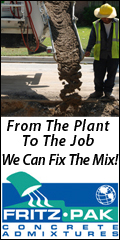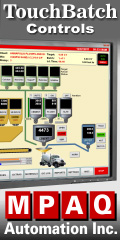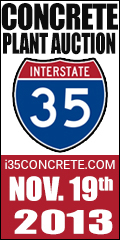NRMCA e-news
National Ready Mixed Concrete Association
NRMCA's celebration of the 100th anniversary of ready mixed concrete in the U.S. concludes its submissions for October with more Producer and Associate member profiles - see below for their respective Web site links. This week's industry milestone: In 1982, Willow Creek Dam in Oregon became the first concrete gravity dam built entirely by roller-compacted concrete methods.
To have your company featured in this space in the coming weeks, please contact
NRMCA's Kathleen Carr Smith at kcarrsmith@nrmca.org or 301-587-1400, ext. 1145.
Dickinson Ready Mix Co. - Dickinson Ready Mix Co. & Concrete Products began operations in May 1950 under the name of Ready Mix Co. The original founders were Taft Sadowsky and L.W. Veigel (who also founded Veigel Engineering which evolved into the present day Kadrmas, Lee & Jackson engineering firm). Longtime company president Jack Olin left the North Dakota Highway Patrol to become general manager of the company in 1961. Today, Dickinson Ready Mix serves 10 counties in southwestern North Dakota with its ready mix operations while the products division has sales in four states. Read more.
An NRMCA producer member 1978
Verifi LLC - The Verifi technology was originally developed in 2002 by an experienced team of ready mix executives from RMC Industries, Inc. in Florida. The team’s goal was to address basic flaws inherent in the ready mix industry’s business model. In December 2010, W. R. Grace & Co. purchased the assets and associated entities of RS Solutions LLC. In November 2011, Ronald Strich joined Verifi as president and purchased a minority share in the company from W.R. Grace & Co. The new entity now operates as an independent company under the name Verifi LLC. Verifi helps concrete producers measure, manage and record critical concrete properties in the truck from batching to discharge, resulting in consistent quality concrete for contractors, engineers and owners. Sensors and controls on the truck automatically add water and admixture within pre-set limits to achieve and maintain the ordered slump. All data is available in real time and is securely stored for viewing later. Read more.
An NRMCA Associate Member since 2012
PROMOTIONS
NRMCA Vice Presidents, National Resources, Amy Miller and Jon Hansen recently met with NRMCA Producer member GCC in its Springdale, AR, office to discuss the Design Assistance Program (DAP). GCC’s Arkansas District Manager Bill Lincks serves on the NRMCA Board or Directors and was recently contacted by Miller; he was delighted to host Miller and Hansen and facilitate discussion of the DAP with his sales and engineering personnel.
"The DAP is an opportunity for members to show value to their customers and aid them in getting more concrete on the ground," Miller said. "There are many inherent benefits that are realized as a result of using the DAP beyond the immediate job success."
If you’d like a national resource director to discuss the Design Assistance Program with your organization, please click here for their respective contact information.
A fast growing regional service station chain in Minnesota was recently offered and incorporated NRMCA's parking lot Design Assistance Program (DAP) for two projects that have just started and is committed to four more for 2013, reports NRMCA Vice President, National Resources, Jon Hansen.
"These projects came as the result of local promotion partners in Minnesota working with this company to meet its goals of updating its station design in light of what the competition is doing," Hansen said.
In a meeting last week at the company headquarters, members of the construction, design, and maintenance division met with Hansen, a local ready mix producer and a cement company to move the DAP work forward to the construction stage. NRMCA’s Amanda Hult will finish the jointing plan this week to be ready for placement this fall.
An interesting comment was made by one of the company executives when the conversation went to the use of exterior lighting for the stations. Hansen said the executive stated that the entire outside would be illuminated by LED lights and he felt using concrete was mandatory when using them. "Every photo we were shown by the lighting people to show how well their lights worked was shown with concrete paving," he said. "It appears dark colored pavement just gobbles up the light where light color pavement really enhances it."
For more information, contact Jon Hansen at jhansen@nrmca.org.
The influence of local partners led Osceola, NE, to choose concrete for its Main Street reconstruction project. Portland Cement Association allies Bill Cook, Nebraska Concrete Paving Association, and Jereme Montgomery, Nebraska Concrete and Aggregates Association, initially worked with the consulting engineer. Prior to the project being open for bidding, they were able to effect an increase in the asphalt pavement section from four inches to six. This made the concrete and asphalt pavement sections equal, although no change was made to 12-inches of crushed base, which is an overdesign for concrete.
Following bidding, Cook and Montgomery advocated for concrete before the Osceola City Council. They presented life-cycle cost arguments that included a projected 15-year service life for asphalt and 30 years for concrete; the consulting engineer in attendance agreed with this analysis. Although the concrete bid was 20 percent higher, council selected it based on the presented LCCA. The Osceola Main Street reconstruction is 13 blocks long and will use 830 tons of cementious material.
Source: Portland Cement Association's Executive Report e-newsletter for October 28, 2013.
NRMCA's Promotion-focused Webinars resume the first full week of November with a full slate of offerings. See below for details and click on the respective links for more information, including online registration.
ASSOCIATION & INDUSTRY NEWS
The preliminary estimate of ready mixed concrete produced in August 2013 is 31.5 million cubic yards, 5.2% higher than in August 2012. The estimated ready mixed concrete production through August 2013 is 198 million cubic yards, 2.4% higher than that during the same period in 2012.
Ready mixed concrete production is estimated from cement shipments reported by the U.S Geological Survey. More details are available for NRMCA members here.
A year after the devastation caused by Hurricane Sandy along parts of Mid-Atlantic and Northeastern states, the RMC Research & Education Foundation has issued a press release as a reminder of the need to consider durability and resiliency when rebuilding communities after a natural disaster. Please click here to view that press release.
The Federal Alliance for Safe Homes (FLASH) has produced a video in the A Tale of Two Homes series, that tells the story of Seth Sochacki and his family, who survived Super Storm Sandy in an ICF home built for his mother-in-law. They watched from the safety of the ICF home as their own wood-frame home was washed away in the surge. Please click here to view that video on YouTube.
For more information on the work of the RMC Research & Education Foundation, please visit www.rmc-foundation.org.
The Fall edition of NRMCA's quarterly magazine, Concrete InFocus, has a number of timely and informative articles available only online, including the 2013 NRMCA Fleet Benchmarking and Costs Survey, giving producers the tools they need to evaluate fleet maintenance and utilization.
ENGINEERING
The ACI Fall Convention in Phoenix was held last week. NRMCA staff attended and is providing an update of some of activities that involved NRMCA representation.
NRMCA Staff Presentations – There were three technical sessions on recycled concrete. NRMCA’s Karthik Obla presented on the Sustainable Use of Crushed Concrete Aggregates in Concrete. NRMCA’s Colin Lobo presented on the Use of Recycled Water in Concrete. ACI provides access of many presentations made during the convention.
130 – Sustainability Committee: The committee continues to struggle to finalize the Guide to Concrete Sustainability. The large scope of the document, size of the committee, special interests and rapid movement of the green building movement continue to hamper the development of this document. NRMCA’s Lionel Lemay worked to develop chapters on materials, production and construction, all of which have been balloted and finalized. The committee continues to take on additional responsibilities such as a new certification called Concrete Construction Sustainability Assessor. This program would be designed to assess an individual's knowledge of sustainable properties of concrete, including thermal mass, durability, pervious concrete, resilience, rating systems, carbon footprint, life cycle analysis, life cycle costing and other best practices. Lionel Lemay maintains representation on ACI 130.
132 – Responsibilities in Concrete Construction: ACI 132 is in the final stages of publishing a document that discusses the responsibilities of all stakeholders on a concrete construction project. It discusses associated responsibility with prescriptive and performance specifications. One last ballot was issued on revisions to the document and the committee spent its time resolving comments from this ballot. The revised document will be forwarded to the ACI review process (TAC review). After addressing comments from TAC, the document is expected to be published in Spring 2014. Colin Lobo maintains representation on ACI 132.
201 – Durability: The 201.2R Guide to Durable Concrete is being revised. All chapters have been completed – only the Introduction and Conclusion needs to be updated. NRMCA has provided input to this document. A Task Group (TG) is working on recommendations for physical salt attack. Recent NRMCA research findings will be provided to this TG. Karthik Obla maintains representation on ACI 201.
211 – Mixture Proportioning: Revisions to the document on concrete mixture submittals have been approved. NRMCA helped update this document which includes examples of prescriptive and performance submittals. Two new documents on mixture adjustments and mixture proportioning with ground limestone powder and mineral fillers have been approved and sent to TAC. NRMCA provided input to both documents. A task group is working on assessing aggregate gradings. Karthik Obla maintains representation on ACI 211.
214 – Strength Tests: This committee is collecting project compressive strength test data to update the table showing the standards of concrete control for both testing variability as well as batch to batch variability. A new future session is planned to discuss 4 x 8 in. and 6 x 12 in. cylinder test results and whether the ACI 318 requirement that three 4 x 8 in. cylinders constitute a test result (as opposed to only two 6 x 12 in. cyinders) needs to be revised. NRMCA is planning to participate in this session. NRMCA also pointed out the need for the committee to provide guidance on how concrete producers and contractors can calculate target average compressive strengths when faced with a PWL specification. PWL specifications attach incentives and penalties based on test results from sub lots and lots. Standard deviations are calculated based on sublot results. Karthik Obla is an associate member.
232 – Fly Ash and Natural Pozzolans: The committee has received TAC comments on a new report on high volume fly ash (HVFA) concrete and will ballot the responses and respond by the next convention. The committee is considering disbanding natural and processed pozzolans into a different committee due to the large number of such materials being increasingly used world-wide. The committee is involved in responding to the TAC suggestions on ACI 232.2R, Use of Fly Ash in Concrete. In the next convention the committee is sponsoring two sessions on Low Portland Cement Content Binders: Hydration and Properties. Karthik Obla is the Chair of ACI 232.
301 – Specifications for Structural Concrete: ACI Committee 301 is working on several revisions to the specification in this cycle. Resolutions of ballots have resulted in revisions to the sections on lightweight concrete, mass concrete, shrinkage compensating concrete, architectural concrete, industrial floor slabs, precast and post-tensioned concrete, reinforcement and tilt up concrete. In the sections on concrete materials, Section 4, committee revisions will continue to evolve as resolution to ballots are completed. Several revisions have improved this section by eliminating unreasonable requirements. The committee is also working on including requirements for alkali silica reactions. The committee will review changes to ACI 318 as the reorganized code gets close to completion. The primary impact to ACI 301 will be the new ACI 318 chapter on Construction Document. ACI 301 is working toward completing its revised specification through the ACI review process (TAC and public review) by Spring 2015 and will continue to follow a schedule of bi-weekly Web conference calls to address resolution to ballots and revisions to the specification. Colin Lobo maintains representation on ACI 301.
318 – Building Code for Structural Concrete: The committee continues its frantic pace of achieving consensus on a reorganized member-based code. At this meeting all design chapters including commentary were completed. The last chapter that remains is the new chapter on Construction Documents. This chapter collects all items that the licensed design professional (engineer of record) needs to include in project specifications and drawings - resulting from the design and all code compliance items. The intent is to reiterate the concept that the Code is written to the licensed design professional and the contractor should not be responsible for Code requirements. These requirements should be stated in construction documents (specifications and drawings).
The generation of this chapter has resulted in elimination and simplification of several code provisions. It will cover requirements for concrete materials and mixtures, production, placing, curing, hot and cold weather concreting, strength acceptance criteria and inspection requirements. The final version of this chapter will be issued for ballot and resolved by December. The completed chapters will be forwarded for the ACI review process – TAC review. The schedule for completion of the revised ACI 318 is by Fall 2014 so that it can be referenced in the 2015 version of the International Building Code. Colin Lobo maintains representation on ACI 318. 325 – Concrete Pavements: The committee currently has five documents under development or revision. The report ACI 325.9R Guide for Construction of Concrete Pavements has been completely revised and the committee is currently responding to TAC comments. The committee has received tentative re-approval of ACI 325.12R-02: Guide for Design of Jointed Concrete Pavements for Streets and Local Roads which was revised by NRMCA's Brian Killingsworth, making U.S. Customary Units as primary and corrected the design thickness tables, while also addressing a few editorial issues. A complete revision with updated thickness tables and other technical revisions has begun and is being led by Killingsworth.
The committee is developing ACI 325.XR Report on Precast Concrete Pavements - State of the Practice which is based upon work completed by Tayabji for SHRP2. The SHRP2 document has become the basis for an ACI design and construction report for precast and prestressed pavements which will be reviewed by the committee over the next few months. The committee is also developing ACI 325.YR Proportioning, Quality Control and Evaluation of Concrete Pavement Strength Relationships. The document is complete and has been balloted. Revisions to the document are being made based upon the ballot comments. A revision is underway of 325.11R Accelerated Techniques for Concrete Paving. Work is nearly complete and will be balloted in the next few months. The effort will harmonize with the proportioning document. Killingsworth will ensure that considerations for streets and local roads will be included in all documents. Brian Killingsworth maintains representation on ACI 325 on concrete pavements. 327 – Roller-Compacted Concrete Pavements: Current activities include resolving TAC comments on the report ACI 327.XR Report on Roller-Compacted Concrete Pavements. The committee has also decided to hold off on development of an RCC specification for materials and construction to supplement report 327.XR until other specifications that are currently under development are completed and then reviewed by the committee. Brian Killingsworth maintains representation on ACI 327.
329 – Performance Criteria for Materials for Ready Mixed Concrete: ACI Committee 329 has completed its response to TAC comments resulting from the ACI review process. This final step will result in the publication of ACI 329R – Guide to Performance Requirements for Ready Mixed Concrete, in Spring 2014. The committee has revised its goals to permit it to develop a guide performance specification for concrete. It has requested permission from ACI to develop this type of document. It is envisioned that this document will provide recommended specification clauses and commentary advising the user on the reasoning and rationale. A primary goal will be to minimize prescriptive requirements and details on means and methods in project specifications. The committee will also provide information to ACI standards committees 301 and 318, suggesting performance-based alternatives to current requirements. The committee plans to develop a standard presentation discussing the benefits of evolving to performance-based specifications for improved quality and to support sustainable construction. Colin Lobo (secretary) and Karthik Obla maintain representation on Committee 329.
330 – Parking Lots: The ACI 330 Committee is completing the ACI 330X "Guide to Design and Construction of Industrial Pavements." Four balloted chapters were reviewed, discussed and eventually approved. The committee will continue to ballot the remaining chapters and prepare for the document for the Technical Action Committee review. The committee also reviewed public comments on 330.1. Amy Miller maintains representation on Committee 330.
332 – Residential Concrete: The committee finalized the 2013 version of the Residential Code Requirements for Structural Concrete (ACI 332-13) and Commentary at this meeting by addressing public comments. NRMCA’s Lionel Lemay worked with the committee to significantly modify the section on durability that now follows more closely the durability requirements of ACI-318, Building Code Requirements for Structural Concrete. The residential code now has new definitions for durability classes, specifically for residential concrete to address freezing and thawing, sulfate and chloride exposure. Despite a more complex process for identifying mixture requirements for residential concrete as a result, the requirements for concrete mixtures remain similar to past versions of the residential code. The committee is currently developing a guide to simplify the process of identifying concrete requirements. Lionel Lemay maintains representation on ACI 332.
522 – Pervious Concrete: The 522 Committee completed a new revision to the specification, ACI 522.1, earlier in the year and the document has been published and is available. The committee is working on updating the accompanying guide. Several ballots were recently completed with more to come. Dr. Norb Delatte, Cleveland State University, discussed PervPave, a software from the American Concrete Pavement Association that allows for structural and hydrological design of pervious concrete. Dr. John Kevern, University of Missouri, presented research involving lightweight aggregates in pervious concrete. Dr. Narayanan Neithalath, Arizona State University, discussed research that evaluated structural efficiency of macro fibers in pervious concrete. As always, there was an update from liaisons in associated organizations: American Society of Civil Engineers, NRMCA’s Pervious Subcommittee, ASTM, Pervious Concrete Pavement Association and the Transportation Research Board. The meeting was finalized with Frank Kozeliski, New Mexico Promoter, presenting some job photos for a lively discussion. Amy Miller maintains representation on ACI 522.
555 – Recycled Materials: The document Removal and Reuse of Hardened Concrete is undergoing revisions and will include discussions on crushed returned concrete aggregates based on research work conducted at the NRMCA Research Laboratory. There is a lot of new interest in recycled concrete aggregate. Karthik Obla maintains representation on ACI 555.
Other News
• ACI has developed a new disaster reconnaissance committee (ACI 133) that will report on the effects of major disasters on concrete construction worldwide.
• An innovation task group (ITG-10) has been developed on alternative cementitious materials. ITG-9 was developed on concrete wind turbine towers.
• The following were recognized with awards at the ACI Opening Session:
The October 2013 Focus newsletter published by the Federal Highway Administration (FHWA) includes the following topics:
• A Nationwide Checkup on Infrastructure Health - Is there a better way to assess the nation's highway infrastructure health? Results from a study on infrastructure health conducted by the Federal Highway Administration (FHWA), in coordination with the American Association of State Highway and Transportation Officials (AASHTO), are now available online in a series of four reports.
• The Future of Pavement Management - What does the future hold for pavement management? Research, development and technology transfer initiatives across the country are expanding the role of pavement management, updating the use of existing tools and technologies, and introducing new tools for highway agencies.
• AAR: Get the Facts - Get the latest news and developments from the Federal Highway Administration's (FHWA) Long-Term Pavement Performance (LTPP) program at two LTPP sessions scheduled for the Transportation Research Board (TRB) 93rd Annual Meeting in Washington, DC.
• Infrastructure Innovation Webinars
• Highway Technology Calendar
Click here to view the newsletter. OPERATIONS, ENVIRONMENTAL, SAFETY & HR
NRMCA’s Plant Manager Certification is specified for all batchmen on federal contract projects. With just the December 10-13 class in Orlando remaining for 2013, do not get placed in the position of winning a contract in early 2014 but not having a batchman certified because NRMCA’s certification schedule doesn't coincide with the start of your contract. Plan ahead: registration is still open for Orlando.
Click here for more course information, including staff contact.
Plan and budget to use the industry’s premier driver training program when deliveries slow in the winter months ahead. The training modules are online and totally self-directed so a supervisor or company trainer is not needed. Instead, NRMCA's Concrete Delivery Professional Certification (CDP) Program is lead by a voice-over instructor whose words are seen in subtitles that support drivers with reading or hearing difficulties. Its design allows mixer drivers access through NRMCA’s Web site at any time, using any internet connection.
Each lesson is just 20 minutes long so a learning module can fit between loads or can be spontaneously accessed on slow or bad weather days at the plant. Lessons also have a stop/start feature, making CDP participation adaptable to a driver’s ever-changing work schedule. Finally, the price has not increased since its initial launch yet the material and delivery system are state-of-the-art. With producers’ need to have cost-effective skill reinforcement for their remaining driving pool, CDP Online gives your frontline representatives the advantage of being the most efficient, skilled and productive driving force representing your business.
For more information, contact NRMCA’s Shawnita Dickens 1-888-846-7622, ext. 1154 or by e-mail, sdickens@nrmca.org.
SUSTAINABILITY
Disclosure and transparency requirements by leading A/E firms are now formalized. In an October 4 article, Ecobuilding Pulse reported on the growing number of architecture and engineering firms requiring Environmental Product Declarations (EPDs) and/or Health Product Declarations (HPDs) from building product manufacturers. These firms, including some of the largest in the U.S.: Perkins+Will, HDR and GGLO, are establishing formal policies regarding material transparency and are collecting data on what goes into a building product.
As previously reported by NRMCA, one of the major drivers for material information is the new concepts from the U.S. Green Building Council’s LEED v4 rating system. EPDs and HPDs are both credit options in the overhauled Material and Resources Category and will have dramatic consequences on building material selection for new buildings and major renovations when LEED v4 is launched at November’s GreenBuild trade show. Failure from manufacturers to disclose may lead to a loss of opportunity in the growing green building movement.
NRMCA has been preparing for the concrete industry’s move toward material transparency by becoming an EPD Program Operator and providing guidance for future developments. NRMCA is also working on a HPD guidance manual enabling concrete producers to meet the new provisions of LEED v4. NRMCA will detail these concepts in the new and revised Webinar course "Concrete's Role in Sustainable Development". These four live Webinars will take place online December 9 - 12. Click here for course and registration information. Click here for the original Ecobuilding Pulse article.
For more information, please contact Tien Peng at tpeng@nrmca.org or 206-913-8535. As previously reported by NRMCA, a number of states have been legislating the use of wood over other building materials for state funded projects. This initiative, called Wood First, has its origins in Canada and migrated its way across the border into the U.S. where it has found interested parties in Washington, Oregon, North Carolina, Maine and Alabama. As you would expect, this preferential treatment of one material over another has attracted strong forestry and timber industries with powerful lobby groups.
Clearly, the effects of this legislation are potentially harmful to the concrete industry. However, there is growing opposition to Wood First initiatives across Canada. An opinion piece seen in the Vancouver Sun calls for dialogue that focuses "on working with governments to develop coherent building standards and codes that are sensible, safe, and sustainable." Moreover, the British Columbia Chamber of Commerce, an original supporter of the measure, is now calling for the revision of the Wood First bill.
NRMCA has developed a strategy to stem the adoption of more Wood First legislation in other regions. To implement this strategy, we must first become aware of local political interests and the competitive drive for market share among local industries. Affiliates and members aware of similar legislation in your states should contact NRMCA as soon as possible so that we can provide assistance.
For more details, view NRMCA's Wood First Web page or contact Tien Peng at 206-913-8535 or tpeng@nrmca.org.
GOVERNMENT AFFAIRS
Last Friday, the U.S. Department of Labor’s Occupational Safety and Health Administration (OSHA) granted a 47-day extension for the comment period deadline for the recently proposed rule to further regulate respirable crystalline silica. While NRMCA is pleased with the needed extension, it is roughly half of the 90 days extension asked for by NRMCA and multiple other industries and organizations. The new comment period deadline is January 27, 2014. As well, the public hearing on the issue to be held in Washington, DC, has been moved to March 18, 2014. To attend the public hearing "notices of intention to appear" must be submitted to OSHA by Thursday, December 12.
Background: On September 12, the Department of Labor’s Occupational Safety and Health Administration (OSHA) published in the Federal Register a proposal to overhaul the current allowable exposure limits for "respirable" crystalline silica. OSHA’s proposed rule has two separate sections, one for general industry and maritime (which the ready mixed concrete industry falls under) and another for the construction industry. In the ready mixed concrete industry, respirable crystalline silica is typically found from chipping out concrete mixer drums or possibly while concrete mixer truck drivers are on an active construction site. OSHA estimates that the ready mixed concrete industry currently has 43,920 workers currently exposed to respirable crystalline silica, 32,110 of which are exposed to levels above the new proposed permissible exposure limit (PEL).
Although NRMCA is still analyzing the proposed rule, these are the main elements:
• Reducing the PEL from 100 μg/m3, averaged over an 8-hour day, down to just 50 μg/m3, averaged over an 8-hour day;
• Required measuring of silica that workers can be exposed to if it is at or above 25 μg/m3, averaged over an 8-hour day;
• Limiting worker access to areas where the PEL is above 50 μg/m3;
• Required dust controls to reduce worker exposure to limits above the new PEL;
• Employers will be required to provide respirators to workers when dust controls cannot reduce worker exposure to limits above the new PEL;
• Medical exams every three years for workers who are exposed to limits for 30 or more days a year above the new PEL;
• New worker training; and
• New recordkeeping requirements.
Click here to view the proposed rule, factsheets, frequently asked questions (FAQs) and more. For more information, contact NRMCA's Gary Mullings at gmullings@nrmca.org or Kevin Walgenbach at kwalgenbach@nrmca.org. On Tuesday, the U.S. Environmental Protection Agency (EPA) extended the comment period for its proposed NPDES Electronic Reporting Rule by 45 days to Thursday, December 12. The proposed NPDES Electronic Reporting Rule is pretty straightforward. Currently, EPA allows paper/hard copies to be submitted for application and renewal of National Pollutant Discharge Elimination System (NPDES) permits, as many ready mixed concrete producers currently are required to obtain. EPA is proposing to switch entirely to an electronic format. Prior to EPA’s comment period extension notice, NRMCA submitted comments on the proposed rule.
While NRMCA is not opposing the proposed rule, NRMCA commented that EPA has underestimated the time necessary to appropriately implement the changes. Specifically, NRMCA commented, "for industry and states to be able to meet the above requirements, more time is needed than proposed. Due to the foreseeable planning, initial investments, training, personnel hiring and necessary troubleshooting, in addition to, EPA, states, tribes and territories developing new electronic reporting tools, NRMCA recommends changing the implementation dates as follows: Phase 1: Three years after effective date of the final rule; Phase 2: Four years after effective date of the final rule. If we have learned anything from the Affordable Care Act (ACA), it is that new computer based programs, software and hardware will inevitably have 'glitches' that will need time to be worked out. Also, NRMCA estimates the cost to the ready mixed concrete industry to be about $500 per plant for training alone. There will certainly be other hardware and software costs which are unable to predict at this time." Click here for more information on the proposed. For more information, contact NRMCA's Gary Mullings at gmullings@nrmca.org or Kevin Walgenbach at kwalgenbach@nrmca.org.
H.R. 3080 – the Water Resource Reform and Development Act of 2013 – passed the House last week by a nearly unanimous vote of 417-3. The bill both reforms and authorizes the programs of the Army Corps of Engineers’ Civil Works programs related to navigation, flood risk management, recreation, infrastructure and environmental stewardship. The results will ensure the Army Corps' ability to effectively expedite projects, prioritize investments, provide resilience, protect communities and maintain our nation’s waterways, ports, channels, dams and levees.
NRMCA’s resilient construction definition – which allows a property to resist hazards brought on by a major disaster and to continue to provide the primary functions of the property after a major disaster – was included in the bill’s report. The next step is to conference the bill with the Senate WRDA Bill, S. 601, which passed the Senate on May 1 by a vote of 87-14. NRMCA’s resilient construction language was included in S. 601 as an amendment offered by Senators Nelson (FL) and Blunt (MO). The resilient construction definition has also been listed by the White House as one of its priorities for WRDA reauthorization. NRMCA will continue to work with members of the conference committee to ensure this language is retained in the final version.
Additionally, Congressman Daniel Webster (FL -10) has offered an amendment to include the same Resilient Construction language in the Federal Emergency Management Agency (FEMA) Reauthorization Act of 2013 (H.R. 3300). H.R. 3300 was introduced last week and is currently before the House Transportation and Infrastructure Committee for consideration.
For more information contact NRMCA’s Kerri Leininger at kleininger@nrmca.org.
Media articles on Congress, transportation infrastructure, regulation, taxes and other subjects, each of which relate to the ready mixed concrete industry, are updated each week by NRMCA's Government Affairs staff. To access the most recent compilation of articles for the Week of October 21 - 25, please click here.
If you would like to receive this weekly updated link in a separate e-mail, or if you have questions or comments about the roundup, contact NRMCA’s Elizabeth Fox at efox@nrmca.org. PRODUCTS & SERVICES
NRMCA's Internet Spotlight, good through Tuesday, November 5, is the new Hazard Communication for the Ready Mixed Concrete Industry Guide. The new Hazard Communication Standards (HCS) from OSHA requires chemical manufacturers, distributors or importers (including ready mixed concrete producers) to make adjustments to their Hazard Communication Plan; NRMCA wants to make sure our members are ready for these new OSHA requirements taking effect on Sunday, December 1. As another vital addition to the NRMCA Safety Series, this CD-based PowerPoint training guide provides the ready mixed concrete producer with the tools to train employees on OSHA's new Hazard Communication Standard changes.
Order this important safety topic online today receive 20% off. Regular member price is $85, Internet Special $68.00, plus shipping. Discount Code: ISOCT13. CALENDAR
*Please note that e-mail and direct links to each event listed below can be accessed from NRMCA's Web site.
November 4, Nashville, TN
Pervious Concrete Technician Certification
Email: Darla Sparkman
November 4, Webinar
Introduction to Concrete Pavement Analyst Software
Email: Shawnita Dickens, 888-84-NRMCA, x1154
November 4, Webinar
The Quantifiable Advantages of Concrete Parking Lots
Email: Shawnita Dickens, 888-84-NRMCA, x1154
November 4-8, Silver Spring, MD
Concrete Technologist Training & Certification "Short Course"
Email: Jessica Walgenbach, 888-84-NRMCA, x1152
November 7, Scottsdale, AZ
Regional ConcreteWorks, Southwest Region
Email: Nicole Maher, 240-485-1158
November 8, Webinar
ACI 330 R-08 – The Gold Standard of Concrete Parking Lot Design
Email: Jessica Walgenbach, 888-84-NRMCA, x1152
November 8, Phoenix, AZ
Pervious Concrete Contractor Certification
Email: Susan Kregar, susan@azconcrete.com
November 12-14, Silver Spring, MD
The Effective RMC Supervisor Course
Email: Shawnita Dickens, 888-84-NRMCA, x1154
November 15, Okemos, MI
Regional ConcreteWorks, Great Lakes Region
Email: Nicole Maher, 240-485-1158
November 19, Webinar
Designing and Specifying Pervious Concrete - Part 1 (*Part 2 on November 26)
Email: Shawnita Dickens, 888-84-NRMCA, x1154
November 20, Free Webinar
STEPS™ A Long Term Career Tool for the RMC Industry
Email: Shawnita Dickens, 888-84-NRMCA, x1154
December 2-3, Online Course
Designing Pervious Concrete Pavement for Municipal & Commercial Applications
Email: Amanda Hult, 303-953-2382
December 3, Webinar
Roller Compacted Concrete: Another Choice for Pavement
Email: Shawnita Dickens, 888-84-NRMCA, x1154
December 3, Sacramento, CA
Handling Concrete Specifications, Low Strength Problems and Mixture Submittals
Email: Jessica Walgenbach, 888-84-NRMCA, x1152
December 3-5, Silver Spring, MD
CCSP II: Customer Business Knowledge
Email: Shawnita Dickens, 888-84-NRMCA, x1154
December 4, Glendora, CA
Handling Concrete Specifications, Low Strength Problems and Mixture Submittals
Email: Jessica Walgenbach, 888-84-NRMCA, x1152
December 4-6, Orlando, FL
Environmental Certification Course
Email: Shawnita Dickens, 888-84-NRMCA, x1154
December 9-12, Online Course and Certification
Concrete's Role in Sustainable Development
Email: Jessica Walgenbach, 888-84-NRMCA, x1152
December 10-13, Orlando, FL
Plant Manager Certification Course
Email: Shawnita Dickens, 888-84-NRMCA, x1154
December 23, Webinar
Designing and Specifying Pervious Concrete - Part 1 (*Part 2 on December 30)
Email: Shawnita Dickens, 888-84-NRMCA, x1154
2014
January 14, Webinar
Concrete Pavement Jointing Plans
Email: Amanda Hult, 303-953-2382
January 15, Free Webinar
STEPS™ A Long Term Career Tool for the RMC Industry
Email: Shawnita Dickens, 888-84-NRMCA, x1154
January 20-23, Webinar
Building Green with Concrete
Email: Tien Peng, 206-913-8535
January 28, Webinar
RCC: Intro to Design and Construction Webinar
Email: Amanda Hult, 303-953-2382
February 11-12, Online Course
Designing Jointed Concrete Pavement for Streets and Parking Areas
Email: Amanda Hult, 303-953-2382
February 18, Webinar
Understanding Asphalt
Email: Amanda Hult, 303-953-2382
February 24-27, Webinar
LCA of Concrete Structures
Email: Tien Peng, 206-913-8535
March 18, Webinar
Controlling Moisture in Concrete Slabs
Email: Amanda Hult, 303-953-2382
March 25, Webinar
Concrete Overlays for Streets and Local Roads and Parking Lots
Email: Amanda Hult, 303-953-2382
May 6, Webinar
Soils 101
Email: Amanda Hult, 303-953-2382
June 17, Webinar
Concrete Pavement Jointing Plans
Email: Amanda Hult, 303-953-2382
August 19, Webinar
Controlling Moisture in Concrete Slabs
Email: Amanda Hult, 303-953-2382
|








